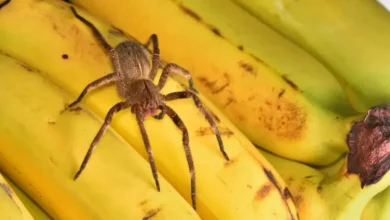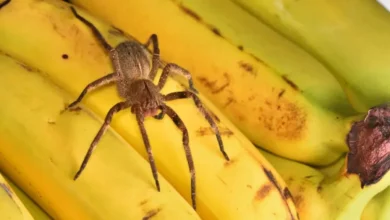Black Widow Spider vs. Tarantula: Arachnid Showdown

The black widow spider and the tarantula are two of the most fascinating and feared creatures in the world of venomous arachnids. They may look similar at first, but they have many interesting differences. This showdown will reveal their venom potency, behaviors, and habitats.
In this guide, we’ll explore the main differences between black widow spiders and tarantulas. You’ll learn about their deadly traits and how to stay safe around them. Get ready to discover the truth about black widow spiders vs. tarantulas and their amazing abilities.
Venomous Arachnids: A Deadly Comparison
Black widow and tarantula spiders are well-known for their venom. But, their venom’s strength and how it affects humans can differ a lot.
Venom Potency and Effects
The black widow’s venom is stronger than the tarantula’s. Its venom can cause muscle pain, nausea, and breathing problems. Tarantula venom, however, is less toxic. It usually just causes pain and swelling where it bites.
Spider Behavior and Aggression
Black widows are more shy and defensive. They only bite when they feel threatened. Tarantulas, though, are less aggressive. They usually run away when faced with danger, not fight back.
| Characteristic | Black Widow Spider | Tarantula |
|---|---|---|
| Venom Potency | Highly Potent Neurotoxin | Relatively Less Potent |
| Venom Effects | Severe Symptoms (Muscle Pain, Nausea, Respiratory Distress) | Localized Pain and Swelling |
| Behavior | Reclusive and Defensive | Less Aggressive, Likely to Flee |
Knowing the differences in venom and behavior is key to understanding these spiders.

Black Widow Spider vs. Tarantula
The black widow spider and the tarantula are two different spider types. They have unique traits and ways of acting. Even though they both have venom, they are quite different.
The black widow’s venom is very dangerous to humans. It can be deadly. Tarantulas also have venom, but it’s not as bad. Their venom feels more like a bee sting.
Black widows are small and shiny black with a red hourglass mark. Tarantulas are big and hairy. They look scarier than black widows. Tarantula bites might hurt a bit, but they’re not as bad as black widow bites.
Black widows are shy and only get aggressive when scared or protecting their eggs. Tarantulas are usually calm but can get defensive. They might warn off predators by raising their front legs or rubbing them together.

 What are the differences between the black widow and the tarantula?
What are the differences between the black widow and the tarantula?
In short, black widow spiders and tarantulas are both venomous but very different. They vary in venom strength, size, looks, and how they act. Knowing these differences helps us appreciate their unique qualities and stay safe around them.
Identifying Dangerous Spider Species
Knowing how to spot dangerous spiders like black widows and tarantulas is key to staying safe. These spiders have clear physical characteristics and markings that make them easy to identify.
Physical Characteristics and Markings
The black widow stands out with its shiny black body and a red hourglass on its belly. These spiders are very venomous and their bites can be deadly, especially for kids and the elderly. In contrast, tarantulas have bigger bodies and come in many colors like brown, black, and even bright blues and reds. While tarantulas are not usually aggressive, their bites can hurt and cause some reactions.
It’s vital to know the unique features of these dangerous spider species. By learning about spider identification and physical characteristics, you can avoid dangerous spiders.
| Spider Species | Physical Characteristics | Markings |
|---|---|---|
| Black Widow | Shiny, black body | Distinctive red hourglass shape on abdomen |
| Tarantula | Larger, more robust body | Variety of colors, including brown, black, blue, and red |
Arachnid Habitats: Where Widows and Tarantulas Lurk
It’s important to know where venomous spiders like black widows and tarantulas live. They have their own special places to call home. Each one has found a way to thrive in its own unique environment.
Black Widow Haunts
Black widow spiders like dark, quiet spots. You might find them in woodpiles, garages, or even cities. They like messy places to spin their webs and catch food. If you’re cleaning or moving things, watch out for them.
Tarantula Territories
Tarantulas, on the other hand, love the outdoors. They live in deserts, grasslands, and forests. They dig burrows or hide under rocks and logs. At night, they come out to hunt. If you’re hiking, be careful where you step.
Knowing where spiders live can help you stay safe. By understanding their habitats, you can protect yourself and your family. It’s all about being aware and taking the right steps.
Spiders come in all shapes and sizes. There are over 40,000 kinds and 109 families. The smallest spiders are tiny, while the biggest can grow up to 10 cm long. Learning about their homes helps us avoid them and enjoy nature more.
Deadly Bite: Venom Toxicity and Symptoms
The venom of black widow spiders and tarantulas can cause different symptoms. The black widow’s venom is often seen as more dangerous to humans. This is because it can be more toxic.
The spider venom of female black widow spiders is twice as toxic as the male’s. In rare cases, a female black widow bite can be fatal, especially for kids or the elderly. Symptoms include intense muscle pain, nausea, and breathing problems.
Tarantulas have venom that usually causes pain and swelling at the bite site. But, some people might have a serious spider bite symptoms like an allergic reaction. If bitten by a venomous spider, it’s important to get medical help right away.
 Why are black widow spiders so deadly?
Why are black widow spiders so deadly?
Knowing about spider venom dangers is key to staying safe. If you’re bitten, knowing what to do can help. Always be careful and informed around these arachnids.
Spider Species Comparison: Size and Strength
Black widow spiders and tarantulas differ in size and strength. Tarantulas are much larger, with some reaching up to 10 inches in leg span. Black widow spiders, on the other hand, are about 0.5 inches in body size. This size difference makes tarantulas stronger and better at catching prey.
Tarantula’s Size Advantage
Tarantulas have more muscle and strength because of their size. This lets them catch and eat prey that black widow spiders can’t. Tarantulas can eat insects, small rodents, and even small reptiles with their strong fangs and bodies.
Even though black widow venom is more potent, tarantulas are often stronger. The tarantula’s size and strength make it a powerful opponent, even with the black widow’s deadly venom.
| Characteristic | Black Widow Spider | Tarantula |
|---|---|---|
| Average Body Size | 0.5 inches | Up to 10 inches (leg span) |
| Venom Potency | High | Moderate |
| Physical Strength | Low | High |
Dangerous Encounters: Safety Precautions
Meeting a black widow spider or a tarantula can be risky. It’s important to take the right steps to avoid getting bitten. Always wear gloves and long sleeves when in areas where these spiders might be. Try not to move suddenly or touch the spiders.
Avoiding Spider Bites
If you think you’ve been bitten by a spider, get help right away. Spider venom can be very dangerous and even deadly. Always put spider safety and spider bite prevention first when dealing with dangerous spider encounters.
- Be careful when moving or disturbing objects in areas where black widows or tarantulas may be present.
- Wear protective clothing, such as gloves and long sleeves, when working in outdoor areas or handling items that could harbor spiders.
- Avoid sudden movements or direct contact with spiders to reduce the risk of a defensive attack or bite.
- Seek immediate medical care if you suspect a spider bite, as prompt treatment can be crucial.
| Safety Precaution | Importance |
|---|---|
| Caution when handling objects | Minimizes the risk of disturbing hidden spiders |
| Wearing protective clothing | Provides a barrier against spider bites |
| Avoiding sudden movements | Reduces the likelihood of provoking a defensive response from spiders |
| Seeking medical attention | Ensures prompt treatment for potentially life-threatening spider venom |
Spider Behavior: Hunting and Defensive Tactics
Arachnids like black widow spiders and tarantulas have different ways of hunting and defending themselves. Black widows are usually shy and defensive. They use their strong venom to scare off predators and catch prey. They wait patiently in their webs for insects or small animals to get caught.
Tarantulas are generally calmer and less aggressive. But they can still defend themselves when needed. They use their size and strong fangs to protect themselves. They also have spider defensive behaviors like standing up on their hind legs or flicking hairs to scare off threats.
Both species have unique hunting styles. Black widows wait in their webs and quickly catch prey. Tarantulas, however, actively chase their prey. They use their size and strength to overpower their targets.
Both black widows and tarantulas show how diverse spider behaviors can be. Their unique traits help us understand the complexity and adaptability of these fascinating arachnids.
Arachnid Fascination: Understanding These Misunderstood Creatures
Black widows and tarantulas are fascinating, yet often misunderstood. These arachnids are key to their ecosystems. They have unique adaptations and behaviors. Learning about them can help you appreciate these creatures and stay safe around them.
Black widows and tarantulas are vital to nature. Black widows eat insects and small prey, controlling pest numbers. Tarantulas are calm and can be pets for those who know how to care for them.
 Tarantulas vs Spiders: Are They Different Creatures?
Tarantulas vs Spiders: Are They Different Creatures?
By understanding spiders better, we can live in harmony with them. With precautions and respect, we can value their role in nature. This way, we stay safe while appreciating their importance.



